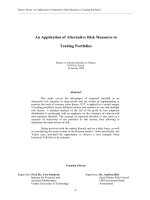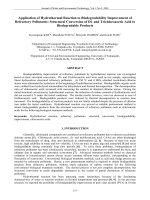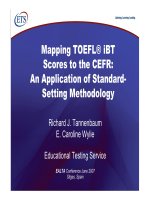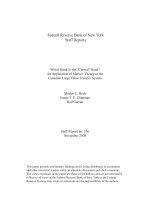An application of genetic algorithm to optimize the 3-Joint carangiform fish robot’ s links to get the desired straight velocity
Bạn đang xem bản rút gọn của tài liệu. Xem và tải ngay bản đầy đủ của tài liệu tại đây (741.66 KB, 10 trang )
TAẽP CH PHAT TRIEN KH&CN, TAP 18, SO K1- 2015
An application of genetic algorithm to
optimize the 3-Joint carangiform fish robot s
links to get the desired straight velocity
Phu Duc Huynh
Tuong Quan Vo
University of Technology, VNU HCM
ABSTRACT:
Biomimetic robot is a new branch of
researched field which is developing
quickly in recent years. Some of the
popular biomimetic robots are fish robot,
snake robot, dog robot, dragonfly robot,
etc. Among the biomimetic underwater
robots, fish robot and snake robot are
mostly concerned. In this paper, we
study about an optimization method to
find the design parameters of fish robot.
First, we analyze the dynamic model of
the 3-joint Carangiform fish robot by
using Lagrange method. Then the
Genetic Algorithm (GA) is used to find
the optimal lengths values of
fish
robots links. The constraint of this
optimization problem is that the values of
fish robots links are chosen that they
can make fish robot swim with the
desired straight velocity. Finally, some
simulation results are presented to prove
the effectiveness of the proposed
method.
Keywords: Biomimetic robot, Carangiform, Fish robot, Lagrange, Genetic Algorithm
(GA), Singular Value Decomposition (SVD), Straight velocity, Links.
1. INTRODUCTION
Fish has been passing over millions years of
evolution throughout many generations to adapt
to the harsh of underwater environment. So more
and more types of fish with diversity movements
were born to be able to exist in natural
environment. Many kinds of fish move by using
the change of their body shape for generating the
movement. This changing shape generates
propulsion force to make fish moves forward
effectively. Carangiform fish type also uses this
changing shape to move itself in the underwater
environment.
Based on the motion mechanism of
Carangiform fish, there are some researches
about this type of motion. Koichi Hirata et al.
discussed turning modes for the fish robot that
uses tail swing [1]. Qin Yan et al. have
experiments to investigate the influences of
characteristic parameters such as the frequency,
the amplitude, the wave length, the phase
difference and the coefficient on forward velocity
of robot fish [2]. And, Yeffry Handoko et al. also
designed three types of body constructions of
robot fish to gain optimal thrust speed [3].
Besides, in our previous research, we used GA
and HCA to optimize parameters of input torques
including amplitude, frequency and phase angle
to gain maximum velocity [4].
In this paper, we consider a 3-joint (4 links)
Carangiform fish robot. We also pay much
attention to the motion of fish robots head in
analyzing the dynamics system of fish robot.
Then, the dynamics system of fish robot are
Trang 27
SCIENCE & TECHNOLOGY DEVELOPMENT, Vol 18, No.K1- 2015
derived by using Lagrange method. The
influences of fluid force to the motion of fish
robot are also considered which is based on
Nakashima’s study on the propulsive mechanism
of a double jointed fish robot [5]. Then, the SVD
(Singular Value Decomposition) algorithm is
also used in our simulation program to minimize
the divergence of fish robot’s linkage system
when simulating fish robot’s operation in
underwater environment.
The main goal of this paper introduces about
the application of GA to optimize the length of
fish robot’s linkage system in order to make the
fish robot swim with the desired straight velocity.
And, the dynamics system of fish robot and some
other related constrains are also considered when
we carry on the optimization problem.
2. DYNAMICS ANALYSIS
In our fish robot, we focus mainly on the
Carangiform fish’s type because of fast
swimming characteristics which resemble to tuna
or mackerel. The movement of this Carngiform
fish type requires powerful muscles that generate
side to side motion of the posterior part (vertebral
column and flexible tail) while the anterior part
of the body remains relatively in motionless state
as seen in Fig. 1.
We design 3-joint (4 links) fish robot in order
to get smoother and more natural motion. As
expressed in Fig. 2, the total length limitation of
fish robot is about 400mm which includes 4
links. The head and body of fish robot are
supposed to be one rigid part (link0) which is
connected to link1 by active RC motor1 (joint1).
Then, link1 and link2 are connected by active RC
motor2 (joint2). Lastly, link3 (lunate shape tail
fin) is jointed into link2 (joint3) by two extension
flexible springs in order to imitate the smooth
motion of real fish. The stiffness value of each
spring is about 100Nm. Total weight of the fish
robot (in air) is about 5 kg.
Increasing size of movement
Transverse axis
Caudal fin
Pectoral fin
Main axis
Anterior part
Posterior part
Tail fin
Figure 1. Carangiform fish locomotion type.
In Fig. 2, T1 and T2 are the input torques at
joint1 and joint2 which are generated by two
active RC motors. We assume that inertial fluid
Trang 28
force FV and lift force FJ act on tail fin only (link
3) which is similar to the concept of Motomu
Nakashima et al [5].
TAẽP CH PHAT TRIEN KH&CN, TAP 18, SO K1- 2015
Y
(link3)
l3
(link2)
l2
(link1)
l1
(link0)
l0
3
a2
T2
T1
m3 (x3,y3)
a3
2 m2 (x2,y2)
a1
1
X
m1 (x1,y1)
Figure 2. Fish robot analytical model.
The expression of forces distribution on fish
robot is presented in Fig. 3 below. FF is the thrust
force component at tail fin, FC is lateral force
component and FD is the drag force effecting to
the motion of fish robot. The calculations of
these forces are similar to Motomu Nakashima et
al method for their 2-joint fish robot [5].
Y
Direction of movement
FJ
FD
FF
FV
FC
X
Figure 3. Forces distribution on fish robot
We suppose that the tail fin of fish robot is in
a constant flow Um so we can derive the inertial
fluid force and the lift force act on the tail fin of
fish robot. Then we can calculate their thrust
component FF and lateral component FC from the
inertial fluid force and lift force. We also suppose
that the experiment condition of testing our fish
robot is in tank so that the value of U m is chosen
as 0.08m/s. Fv is a force proportional to an
acceleration acting in the opposite direction of
the acceleration [5]. The calculation of FV is
expressed in Eq. (1). The lift force FJ acts in the
perpendicular direction to the flow and its
calculation as in Eq. (2). In these two equations,
chord length is 2C, the span of the tail fin is L
and is waters density.
FV = pr LC 2U&sin a + pr LC 2a&U cos a
(1)[5]
FJ = 2pr LCU 2 sin a cos a
(2)[5]
These fluid force and lift force are divided
into thrust component FF in x direction and
lateral force component FC in y direction as
presented in Fig. 4.
In Fig. 4, U is the relative velocity at the
center of the tail fin, is the attack angle.
Trang 29
SCIENCE & TECHNOLOGY DEVELOPMENT, Vol 18, No.K1- 2015
Y
Y
FFV
FCJ
FJ
FFJ
U
U
FCV
FV
X
X
Figure 4. Model of inertial fluid force and lift force
Based on Fig. 4, the value of FF and FC can be
calculated by these two Eqs. (3)-(4):
FF = - FV sin (q1 + q2 + q3 )+ FJ sin (q1 + q2 + q3 )
(3)
FC = FV cos (q1 + q2 + q3 )- FJ cos (q1 + q2 + q3 )
(4)
If we just consider the movement of fish robot
in x direction, so the relative velocity in y
direction at the center of tail fin is calculated by
Eq. (5).
(6)
u
& &
u = q&
1l1 cos q1 + (q1 + q2 )l2 cos (q1 + q2 )+
& &
+ (q&
1 + q2 + q3 )a3 cos (q1 + q2 + q3 )
(5)
Since Um and u are perpendicular as in Fig.
5(a), so the value of U can be calculated by Eq.
(6):
U 2 = U m2 + u 2
U
Um
U
(a)
(b)
Figure 5. (a) Relationship between U and Um.
(b) Diagram of attack angle calculation.
By using Lagrange’s method, the dynamic
model of fish robot is described briefly as in Eq.
(7).
éM 11
ê
êM 21
ê
êM
ë 31
Trang 30
M 12
M 22
M 32
&ù
M 13 ùéêq&
ú 1ú
ê&
&ú
M 23 ú
úêq2 ú=
ê
ú
ú
&
M 33 ûêq&
ë 3ú
û
éN1 ù
ê ú
êN 2 ú
ê ú
êN ú
ë 3û
(7)
By solving Eq. (7) above, we can get the
value of qi , q&
i (i = 1 3). However, based on
the dynamic model in Eq. (7), SVD (Singular
Value Decomposition) algorithm is also used in
our simulation program to minimize the
divergence of the oscillation of fish robot’s links
when simulating the operation of fish robot in
underwater environment. This divergence also
cause the velocity of fish robot be diverged too.
TAẽP CH PHAT TRIEN KH&CN, TAP 18, SO K1- 2015
The motion equation of fish robot is
&
expressed in Eq. (8). x&
G is the acceleration of
fish robots centroid position. m is the total
weight of fish robot in water. FF is the propulsion
force to push fish robot forward and FD is drag
force caused by the friction between fish robot
and the surround environment when fish robot
swims.
r
r& r
(8)
mx&
= F - F
G
F
D
The calculation of FD is presented in Eq. (9)
FD =
1 2
r V CD S
2
(9)
Where r is the mass density of water. V is
the velocity of fish robot relative to the water
flow. CD is the drag coefficient which is
assumed to be 0.5 in the simulation program. S
is the area of the main body of fish robot which is
projected on the perpendicular plane of the flow.
3. OPTIMIZING THE LENGTH OF FISH
ROBOT LINKAGE SYSTEM BY USING
GENETIC ALGORITHM
Genetic Algorithm [6], [7], [8] is an
optimization method which is based on the
Darwins theory of evolution. Algorithm begins
with a set of solutions (represented by
chromosomes)
called
population.
Each
chromosome is a binary string including shorter
strings that contain value of optimization
variables. Chromosomes in population will be
taken and used to form a new population which is
hoped to be better than the old one. Some
chromosomes that have the best value (offspring)
according to their fitness will have chance to live
in new population. The chromosomes evolve
during several iterations called generations. In
every generation, chromosomes are evaluated,
crossover and mutated to create a new
population.
In our research, the mainly problem is how to
find the length of each fish robots link. In this
case, we dont concern about the cross-sectional
area of the links. The optimization algorithm by
GA is introduced in Fig. 6 below.
Start
Initial
Population
Decoding
chromosomes
New
population
Add the two remained
chromosomes into new
population
Mutation
Crossover
Evaluate fitness
function
Velocity_eval
Desire_velocity
Yes
No
Chose the two
best
chromosomes to
keep
Display the best
chromosome and the
best fitness value
End
Spin the roulette wheel to
from new population
Calculate cumulative
probability
Figure 6. The optimization algorithm by GA
Trang 31
SCIENCE & TECHNOLOGY DEVELOPMENT, Vol 18, No.K1- 2015
The Carngiform fish robot includes 4 links
(link0, link1, link2 and link3) as seen in Fig.1.
We assume the length of head of fish robot (link
0) is fixed and equal 200 mm. Therefore, the
length of link 1, link 2 and link 3 must be
calculated or chosen suitably. However, there are
not much methods to choose the exact value of
these parameters. So, in this paper, we use the
Genetic Algorithm to find the optimal length
values of three remain values of fish robot links
as link1, link2 and link3. The fitness function
includes the fish robot’s dynamic model, the
motion equation and also the desired straight
velocity of fish robot. In these three parameters,
the straight velocity is used as the stop condition
for the GA. In this paper, the desired velocity of
fish robot is chosen as 0.3 m/s and the total
length of link1, link2 and link3 is around 400
mm. The constraints of the optimization problem
by GA are as in Eq. (9):
50 mm ≤ l1 ≤ 250 mm
50 mm ≤ l2 ≤ 250 mm
(9)
50 mm ≤ l3 ≤ 150 mm
395 mm ≤ l1 + l2 + l3 ≤ 405 mm
4. SIMULATION RESULTS
By using GA, the optimal value of l1, l2, l3
will be generated simultaneously based on their
constraints as seen in Eq. (9). The results of GA
is calculated with two different desired straight
velocity of fish robot. The first value of straight
velocity is 0.3m/s and the second one is 0.15m/s.
In every case, the GA will be run in 10 times to
find 10 different values of optimal parameters
sets. Then, based on the results of these, we will
chose the parameters set that has the value which
is the closet to the desired value of straight
velocity. The range of straight velocity error that
we use in our program is ± 0.01 m/s.
The table 1 below introduces about the result
of GA when we use the desired straight velocity
of fish robot is 0.3m/s.
Table 1. Optimal result by GA (Desired straight velocity = 0.3m/s)
From the results in table 1, we chose the best
result of running GA to apply to the dynamic
model. As seen in table 1, the best result is N =8.
The reason that we choose N = 8 as the best one
because it has the value of the straight velocity is
the closet to the desired straight velocity as
0.3m/s. This case is called the optimal case.
In the dynamic model, we use a fixed set of
control parameters including amplitude (A1 and
A2), frequency (f1 and f2) and phase angle β. In
order to prove the effectiveness of the GA
results, we compare the result of GA with the
result of an arbitrary value of l1, l2 and l3. The
arbitrary value of these parameters are chosen
randomly by manual with respect to the constrain
Trang 32
as in Eq. (9) above. This case is called the nonoptimal case. The results of fish robot straight
velocity when we apply the results from GA and
the arbitrary values are introduced in Fig. 7 and
Fig. 8 below.
When we apply arbitrary set of l1, l2, l3 which
are satisfy according to constraints mentioned in
Eq. (9) (with l1 = 0.1995m, l2 = 0.2352m, l3 =
0.13m), the straight velocity of fish robot cannot
reach to the desired value as 0.3m/s. As in Fig 7
below, after 20 second, the straight velocity of
fish robot is about 0.25m/s and it will take long
time to reach to the desired value or it cannot
reach to the desired velocity.
TAẽP CH PHAT TRIEN KH&CN, TAP 18, SO K1- 2015
The relation between moving distance and time
Moving distance (m)
4
3
2
1
Velocity of fish robot (m/s)
0
0
2
4
6
8
10
12
14
16
Time (s)
The relationship between real velocity and time
18
20
0
2
4
6
8
18
20
0.4
0.3
0.2
0.1
0
10
Time (s)
12
14
16
Figure 7. The velocity and the moving distance of fish robot in non-optimal case.
The result of fish robot straight velocity when
we apply the result from GA is introduced in Fig.
8 below. In this figure, the fish robot take about
14 seconds to reach to the desired velocity. And,
the value of fish robot straight velocity is also
kept during the concerning time as shown in Fig.
8.
The relation between moving distance and time
Moving distance (m)
6
4
2
Velocity of fish robot (m/s)
0
0
2
4
6
8
10
12
14
16
Time (s)
The relationship between real velocity and time
18
20
0
2
4
6
8
18
20
0.4
0.3
0.2
0.1
0
10
Time (s)
12
14
16
Figure 8. Velocity and moving distance of fish robot using the result of GA (N = 8) as in Table 1 optimal case
Trang 33
SCIENCE & TECHNOLOGY DEVELOPMENT, Vol 18, No.K1- 2015
Besides, by comparison between the
oscillation of fish robot’s linkage system in the
caudal part , the values of l1, l2, l3 using by GA
will also make fish robot’s caudal part oscillate
with bigger amplitude than the value of the l1, l2,
l3 in arbitrary case. This reason also make the
combination of fish robot better and they can
help fish robot reach to the desired velocity
faster.
Link1 displacement(Degree)
Link 1
10
5
0
-5
Link3 displacement(Degree)
Link2 displacement(Degree)
-10
0
2
4
6
8
10
Time (s)
Link 2
12
14
16
18
20
0
2
4
6
8
10
Time (s)
Link 3
12
14
16
18
20
0
2
4
6
8
10
Time (s)
12
14
16
18
20
6
4
2
0
-2
-4
1
0.5
0
-0.5
-1
Figure 9. Fish robot linkage system’s oscillation in optimal case by GA.
The oscillation of fish robot’s linkage system
in two cases (optimal and non-optimal case) are
introduced in Fig. 9 and Fig. 10 below. And, if
we consider about the oscillation of the third
links in the non-optimal case, we can see that this
link has the trend to be diverged by time as seen
in Fig. 10.
Link1 displacement(Degree)
Link 1
10
5
0
-5
Link3 displacement(Degree)
Link2 displacement(Degree)
-10
0
2
4
6
8
10
Time (s)
Link 2
12
14
16
18
20
0
2
4
6
8
10
Time (s)
Link 3
12
14
16
18
20
0
2
4
6
8
10
Time (s)
12
14
16
18
20
4
2
0
-2
-4
1
0.5
0
-0.5
-1
Figure 10. Fish robot linkage system’s oscillation in non-optimal case.
Besides, there is not only the length of fish
robot links, the Genetic Algorithm can also be
used to find the optimal values of other design
Trang 34
parameters or control parameters of fish robot.
This is the strongest point of Genetic Algorithm
in comparison to other optimal methods.
TẠP CHÍ PHÁT TRIỂN KH&CN, TẬP 18, SỐ K1- 2015
5. CONCLUSION
In our research, we considered the dynamic
model of a 3-joint Carangiform fish robot. And,
the influence of fluid forces which act on motion
of fish robot in underwater environment are also
considered. Besides, these SVD algorithm is used
in the simulation program to reduce the
divergence of fish robot links when solving the
matrix of its dynamic model.
By using GA, we found the optimal length of
fish robot links l1, l2 and l3. And, these optimal
design parameters will help fish robot reach the
desired straight velocity as 0.3m/s in very short
time. And, the results of this paper show that the
lengths of robot fish linkage system also have
great influence to its velocity. In the next step,
some experiments will be carried out to check the
agreement between the simulation results and the
experimental results.
ACKNOWLEDGEMENT:
This research is
funded by Viet Nam National University Ho Chi Minh
City (VNU-HCM) under Grant number B-2013-20-01.
Ứng dụng giải thuật di truyền trong tối ưu hóa
kích thước dài các khâu của robot cá 3 khớp
dạng carangiform để robot cá có thể di chuyển
với vận tốc dài mong muốn
Phu Duc Huynh
Tuong Quan Vo
Trường Đại học Bách Khoa, ĐHQG-HCM
TĨM TẮT:
Robot phỏng sinh học là một hướng
nghiên cứu mới đang được phát triển
mạnh trong những năm gần đây. Một số
robot phỏng sinh học phổ biến là robot
cá, robot rắn, robot chó, robot chuồn
chuồn,…Trong những loại robot dưới
nước này, robot cá và robot rắn được
đặc biệt quan tâm nhiều. Bài báo này
giới thiệu một phương pháp trong việc
tối ưu hóa để tìm ra các thơng số thiết
kế của robot cá. Đầu tiên, phương pháp
Larange được sử dụng để tìm ra bộ
động lực học của robot cá 3 khớp dạng
Carangiform. Sau đó, giải thuật di truyền
được sử dụng để tìm các giá trị kích
thước dài tối ưu các khâu của robot. Sự
rang buộc của bài tốn tối ưu là kích
thước dài các khâu của robot được lựa
chọn sao cho robot có thể di chuyển với
một vận tốc dài mong muốn. Sau cùng,
vài kết quả mơ phỏng sẽ được giới thiệu
để chứng minh tính hiệu quả của
phương pháp này.
Từ khóa: Robot phỏng sinh học, Carangiform, Robot cá, Larange, Giải thuật di
truyền, SVD, Vận tốc thẳng, Các khâu.
Trang 35
SCIENCE & TECHNOLOGY DEVELOPMENT, Vol 18, No.K1- 2015
REFERENCES
[1].
[2].
[3].
[4].
Koichi Hirata*, Tadanori Takimoto** and
Kenkichi Tamura***, Study on Turning
Performance of a Fish Robot, *Power and
Energy Engineering Division, Ship
Research Institute, Shinkawa 6-38-1,
Mitaka, Tokyo 181-0004, Japan, **Arctic
Vessel and Low Temperature Engineering
Division, Ship Research Institute, ***Japan
Marine Science and Technology Center.
Qin Yan, Zhen Han, Shi-wu Zhang, Jie
Yang, Parametric Research of Experiments
on a Carangiform Robotic Fish, Journal of
Bionic Engineering 5 (2008) 95–101.
Yeffry Handoko*, Yul.Y.Nazaruddin*,
Bambang Riyanto** and Edi Leksono*,
Body Construction of Fish Robot in Order
to Gain Optimal Thrust Speed, *Department
of Engineering Physics, **School of
Electrical Engineering and Informatics,
Insitut Teknologi Bandung, J1. Ganesa 10
Bandung 40132, Indonesia.
Tuong Quan Vo, A Study on Dynamic
Analysis
and
Straight
Velocity
Trang 36
Optimization of 3-Joint Carangiform Fish
Robot Using Genetic-Hill Climbing
Algorithm, The 6th Vietnam Conference on
Mechatronics (2012).
[5].
Motomu Nakashima, Norifumi Ohgishi and
Kyosuke Ono, A study on The Propulsive
Mechanism of a Double Jointed Fish Robot
Utilizing Self-Excitation Control, JSME
International Journal, Series C, Vol. 46, No.
3, pp. 982-990, 2003.
[6].
Yingsong Zheng, Sumio Kiyooka, Genetic
Algortithm Applications, Mech 580,
Quantitative Analysis, Reasoning and
Optimization Methods in CAD/CAM and
Concurrent Engineering, Nov. 5, 1999.
[7].
Colin R. Reeves, Jonathan E. Rowe,
Genetic Algorithms – Principles And
Perspectives, A Guide to GA Theory,
Kluwer Academic Publishers, 2003.
[8].
Randy L.Haupt, Sue Ellen Haupt, Practical
Genetic Algorithms – Second Edition, A
John Willey & Son, Inc., Publication, May
2004.









